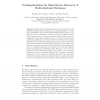Free Online Productivity Tools
i2Speak
i2Symbol
i2OCR
iTex2Img
iWeb2Print
iWeb2Shot
i2Type
iPdf2Split
iPdf2Merge
i2Bopomofo
i2Arabic
i2Style
i2Image
i2PDF
iLatex2Rtf
Sci2ools
PKDD
2007
Springer
2007
Springer
Pruning Relations for Substructure Discovery of Multi-relational Databases
Multirelational data mining methods discover patterns across multiple interlinked tables (relations) in a relational database. In many large organizations, such a multi-relational database spans numerous departments and/or subdivisions, which are involved in different aspects of the enterprise such as customer profiling, fraud detection, inventory management, financial management, and so on. When considering multirelational classification, it follows that these subdivisions will express different interests in the data, leading to the need to explore various subsets of relevant relations with high utility with respect to the target class. The paper presents a novel approach for pruning the uninteresting relations of a relational database where relations come from such different parties and spans many classification tasks. We aim to create a pruned structure and thus minimize predictive performance loss on the final classification model. Our method identifies a set of strongly ...
| Added | 09 Jun 2010 |
| Updated | 09 Jun 2010 |
| Type | Conference |
| Year | 2007 |
| Where | PKDD |
| Authors | Hongyu Guo, Herna L. Viktor, Eric Paquet |
Comments (0)

